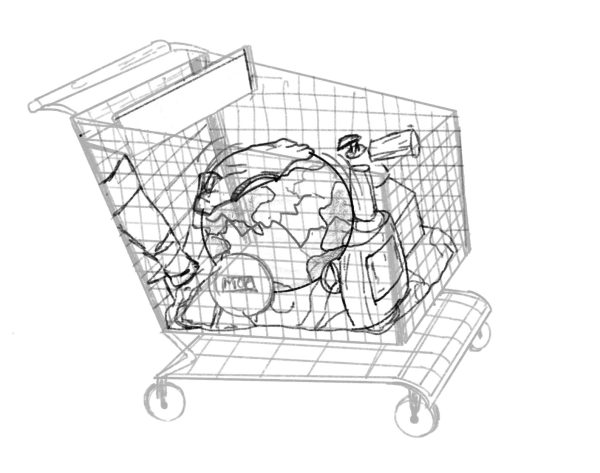On Sep. 12, 2023, TikTok finally joined the long list of social media sites with integrated e-commerce or digital stores. Pinterest, Snapchat, Instagram, Facebook and now TikTok all have links and digital check-outs built into their app. Every update seems to come with more ads, sponsored content or algorithmic marketing to manipulate viewers into emptying their wallets. It’s extremely effective, too. With the amount of free time people seem to spend scrolling on these apps, it’s easy to imagine how effective the stores would be. According to Pew Research, 43 percent of consumers reported shopping on one of these social media stores. In a society driven by capitalistic ideals and endless consumerism, modern social media’s pervasive influence on users’ consumption rate seems almost criminal. It’s time we, as a society, acknowledge how the continuous influence of social media has impacted consumption patterns as a whole.
It has been nearly 30 years since the first recognizable social media platform was released, immediately taking the world by storm. Whether through images, messages, or videos, the global community became hooked on the convenient level of connectivity. The entire idea of these apps was to provide authentic communication for people across the globe. MySpace, a popular social networking website of the early 2000s, even boasted the tagline, “A place for friends.” Compared to today’s overflowing product placement and purchase links, it’s hard to find the transition from MySpace’s authenticity to this new-age advertisement.
This digital shift seems to trace back to the unsuspected “Mommy Bloggers.” Their paid advertising of products was so inconspicuously effective that the Federal Trade Commission (FTC) eventually passed a “Mommy Blogger” law in 2012, which enforced the disclosure of paid endorsements within the first line of any blog. The problem is that this law solely applies to “blogging” or written endorsement, meaning it is irrelevant when it comes to any kind of video or photograph, as is the case with most endorsed media today. This loophole is what inevitably produced the modern influencer.
Arguably, influencers have been around since the beginning of civilization. Tracing all the way back to the 1760s, the Queen of England promoted a specific medicine, artist or potter to the entire nation, driving all nobles and elites to their business. How is this any different from the modern influencers today? In a way, the famous, rich influencers of the modern era are nobles and follow the centuries-old product endorsement pattern.

The difference between endorsing products in a royal court and online lies in the numerous differences in audience. When the Queen decrees that she is endorsing a product, it’s solely to a room of the most elite members of society, holding maximally a couple of hundred people. However, a modern influencer’s advertisement could reach millions or even billions. These modern influencers have much wider audiences than ever before and are much less forthcoming about their brand deals. For the first time in history, people are making income from viewers purchasing their promoted products. A survey conducted by CBS News states that over 49 percent of modern consumers rely on influencers for purchases. Payments from businesses to creators for these product promotions yield thousands of dollars in “brand deals.” Even influencers who claim to be unbiased in their marketing of products are still making money off of their endorsement. Oftentimes, these products are sold out for weeks, if not months, just because of one video promotion. Lon Safko, the author of “The Social Media Bible,” even goes as far as to describe this new social media format as having “a serious lack of credible, truthful and unbiased sources of information.”
The issue isn’t only in the manipulative tactics of brands and creators, but the effect on the world around us that overconsumption has. Factories pump out exorbitant amounts of remarkably cheap clothes. Massive cargo ships then haul these products from sweatshops to warehouses and malls all around the globe. Even the collection of these material masses destroys forests and pollutes oceans. In fact, 80 percent of the world’s natural resources have been used for only the top 20 percent of the global population.
While the chance of reverting to a pre-industrialized consumption rate is unlikely, we can still make changes to correct the damages caused by overconsumption. It may seem impossible to start lessening your consumption, but there are steps we can all take to improve our lives for the better. Try to look at purchases from a different mindset, viewing your closet’s quality before its quantity. Think about what you like and who you are outside of the constant influence of revolving door trends. Before buying another product, think carefully about why you want it and if it’s worth the detrimental effects of the item’s production.




